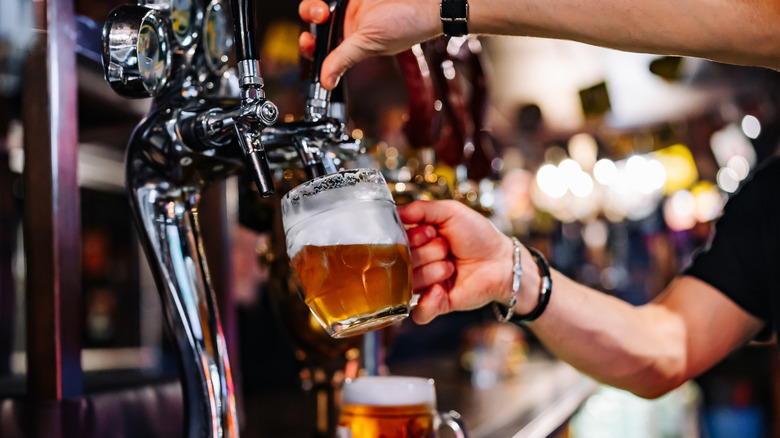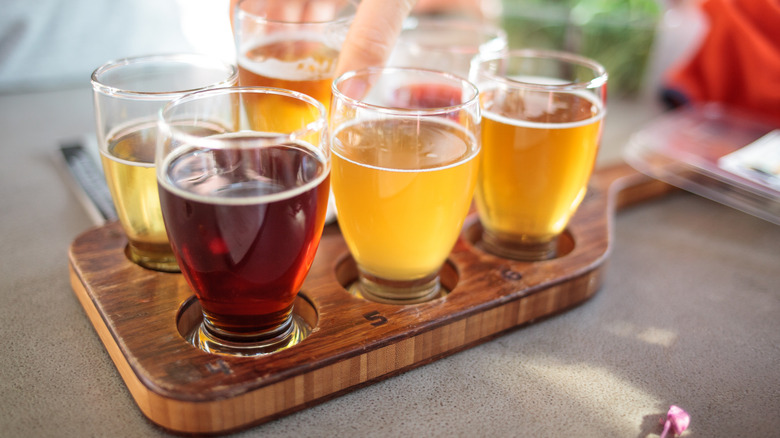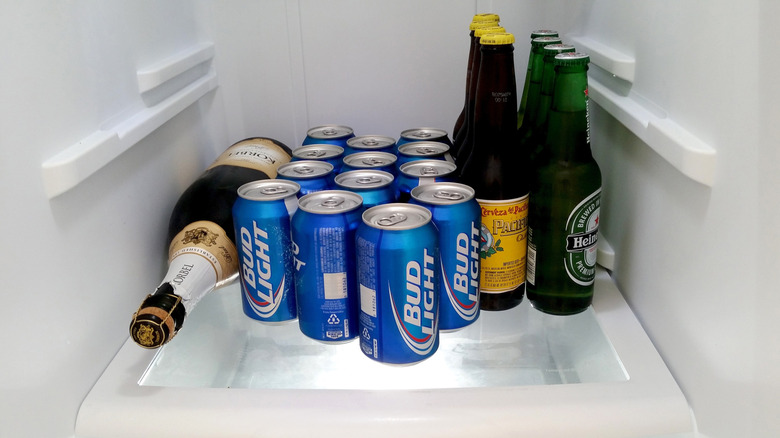Never Sip Stale Beer On Tap Again With One Easy Bar Tactic
If you've ever wondered if beer expires, the answer is yes, yes it does. That is to say, it's not hazardous to drink old beer, but the experience will likely be less enjoyable than drinking one that is fresh out of production. But how do you know how fresh a beer is when you order one on tap?
One answer is surprisingly simple: Drink local. With more than 9,700 craft breweries in the U.S. as of 2023, it's likely one is within a short drive from where you live, or even within walking distance from home. And because local beer has a short distance to travel from fermentation vessel to keg to tap, it's more likely to be fresh.
A common tactic to avoid a stale brew is to ask your server when the beer you're about to spend your hard-earned cash on was kegged. In the common event that they don't know, your next step is to request a sip before ordering. Most establishments that serve brews on tap stock small tasting glasses for this exact purpose, so don't be afraid to ask.
The 3-30-300 rule for beer
Four things contribute to the deterioration of your favorite brews: light, heat, oxygen, and time. Much like fine wine, some beers improve over time and, in fact, require longer periods of aging in the bottle or serving vessel. Examples include barley wines, imperial stouts, and Belgian quads. Imperial pale ales (otherwise known as IPAs) and other hop-forward or lighter brews like pale ales and wheat beers are more volatile. Regardless, beers stored in dark and consistently cold temperatures fare far better than those exposed to light and heat. If you find the beer you're hankering for displayed at room temperature in the store, you may find yourself unsatisfied upon drinking it.
A major culprit of beer degradation is oxidation, which is unavoidable. When beer is pumped into its ultimate storage container — be that bottle, keg, or can — there will always be a bit of air left inside. Hence the 3-30-300 rule, which refers to the number of days a beer will stay fresh when stored at different temperatures. According to this rule, beer will avoid an abundance of oxidation for three days when stored at 90 degrees Fahrenheit, 30 days at 72 degrees Fahrenheit, and it will stay fresh for 300 days when stored at 35 degrees Fahrenheit — that last being the recommended temperature for a typical refrigerator.
The expiration date rules for bottles and cans
Most beer manufacturers provide an expiration or "best by" date on their containers. But breweries differ about how to calculate that date. So, unless the date on the bottle or can follows "bottled on," you can't really tell how fresh a store-bought beer is. That being said, it's a good starting point; imbibing it after that date is a gamble on taste.
When the chemical compounds in hops are exposed to ultraviolet light, it causes a reaction that turns the beer "skunky." You'll know if you ever taste a beer that's gone bad in this way. As such, cans tend to protect beer better than bottles. Dark-tinted bottles are superior to clear or green bottles in defending liquid gold from light exposure.
Once you get it home, there are tried-and-true suggestions on how you should actually store your beer. The fridge is best; a cold, dark place like a cellar would be the second choice. Additionally, storing those cans or bottles upright exposes less of the liquid to air left in the container, thus extending the beer's tasty lifespan.


